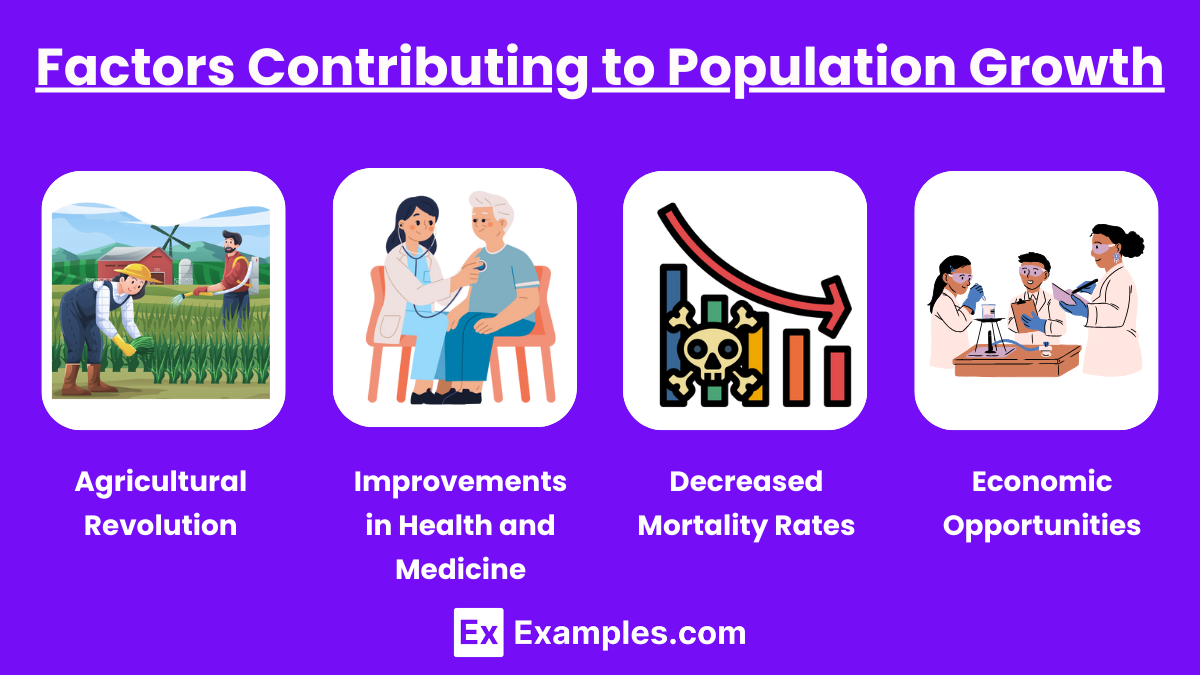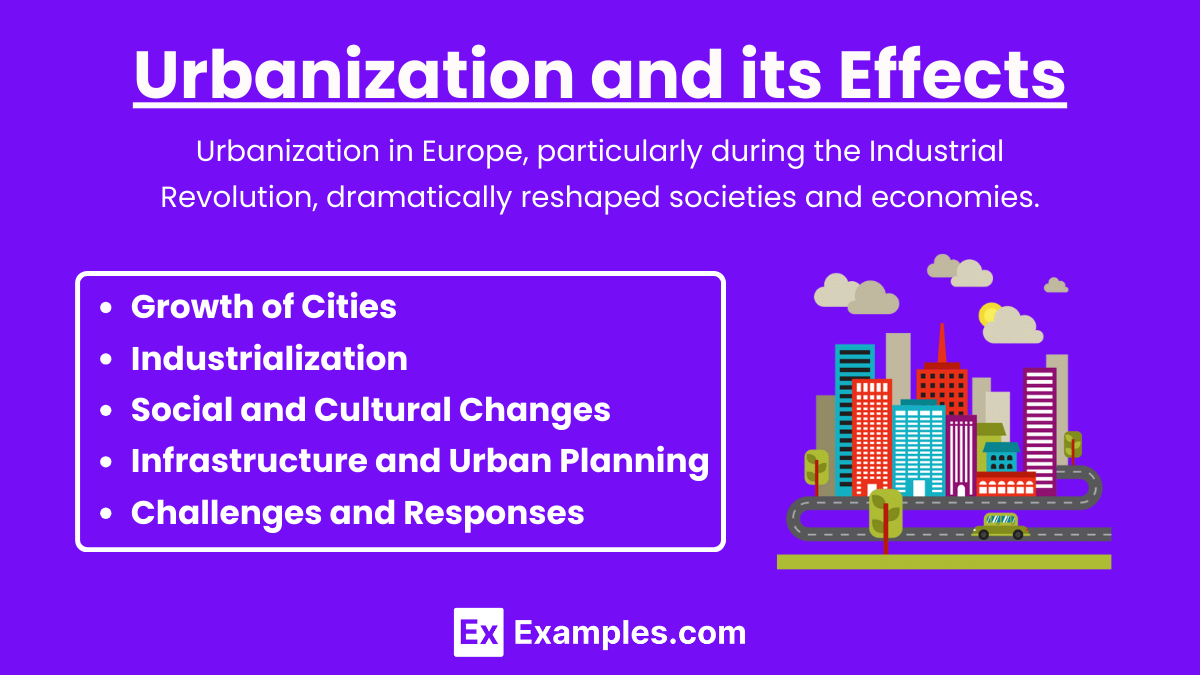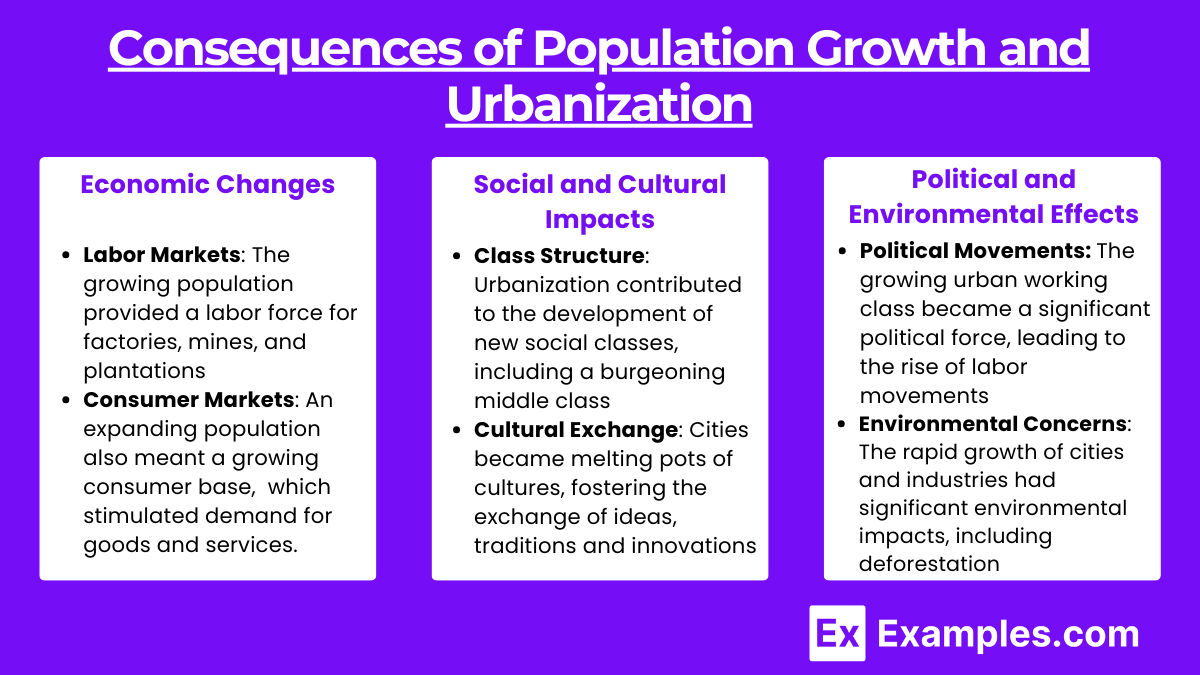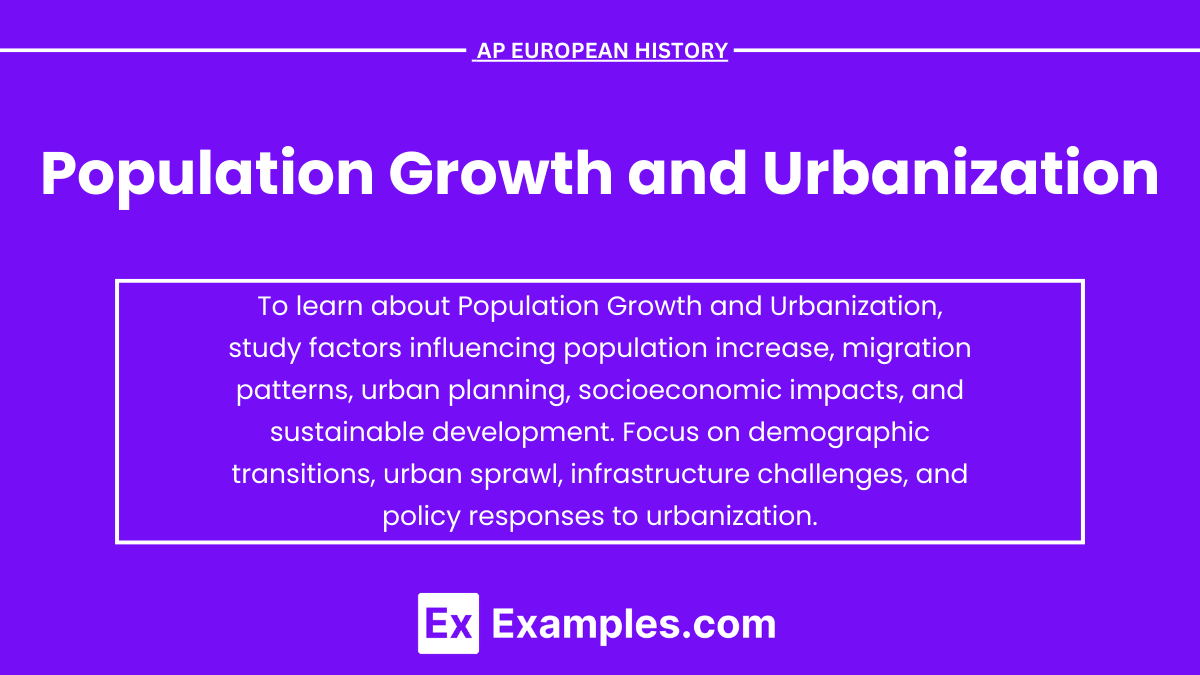The period from the 18th to the early 20th century in Europe was characterized by significant population growth and urbanization. This era, driven by the Agricultural and Industrial Revolutions, saw advancements in agriculture, health, and industry that spurred rapid demographic changes. As people moved from rural areas to urban centers seeking better economic opportunities, cities expanded dramatically. This transformation not only reshaped Europe's social and economic landscapes but also influenced political and cultural developments, laying the groundwork for modern European societies.
Learning Objectives
For the AP European History exam, focus on understanding the causes and consequences of population growth and urbanization in Europe from the 18th to the 20th centuries. Study the impact of the Agricultural and Industrial Revolutions, the social and economic changes in urban centers, and the challenges of rapid urbanization. Analyze the responses to these challenges, such as public health reforms and urban planning initiatives. Grasp the role of migration, both within Europe and to other continents, in shaping urban demographics and cultural dynamics.
Factors Contributing to Population Growth

Population growth in Europe from the pre-industrial era to the Industrial Revolution was marked by significant changes. Initially, Europe's population was stable, but the Black Death in the 14th century caused a dramatic decrease. However, the population began to recover with the advent of improved agricultural practices, such as the three-field system and the introduction of new crops like potatoes. The Early Modern Period witnessed the Agricultural Revolution, which boosted food production through innovations like crop rotation and selective breeding, while economic expansion and mercantilism also supported population growth. The 18th century saw a demographic boom due to declining mortality rates, improvements in medicine, sanitation, and public health, and the onset of industrialization, which drew people from rural areas to growing urban centers.
Agricultural Revolution:
The Agricultural Revolution in the 18th century led to increased food production.
Innovations such as crop rotation, selective breeding, and the introduction of new crops (e.g., potatoes) improved yields.
The Enclosure Movement in England consolidated land, leading to more efficient farming practices.
Improvements in Health and Medicine:
Better medical knowledge and practices, including the smallpox vaccine, reduced mortality rates.
Improvements in sanitation and the understanding of hygiene decreased the spread of diseases.
Decreased Mortality Rates:
Lower infant mortality rates contributed significantly to population growth.
Improved nutrition and living conditions also played a role.
Economic Opportunities:
The Industrial Revolution created new job opportunities, attracting people to urban centers.
The prospect of better living standards in cities encouraged migration from rural areas.
Urbanization and its Effects

Urbanization in Europe, particularly during the Industrial Revolution, dramatically reshaped societies and economies. Rapid urban growth led to the development of industrial cities, which became centers of employment, innovation, and economic activity. However, this shift also brought significant challenges, including overcrowded housing, inadequate sanitation, and pollution, which affected public health and living conditions. Socially, urbanization contributed to the rise of new social classes, such as the industrial working class and the bourgeoisie, and sparked movements for labor rights and political reform. Additionally, the environmental impact of urban expansion, such as deforestation and increased waste, became a growing concern.
Growth of Cities:
Urbanization accelerated in the 19th century as people moved to cities in search of work in factories and industries.
Major cities like London, Paris, and Berlin experienced rapid population growth.
Industrialization:
The rise of factories and industries in urban areas led to a demand for labor.
Urban centers became hubs of economic activity, fostering innovation and technological advancements.
Social and Cultural Changes:
The concentration of diverse populations in cities led to new social dynamics and cultural exchanges.
Urbanization contributed to the development of new social classes, including a growing middle class and a distinct working class.
Infrastructure and Urban Planning:
Rapid urban growth necessitated the development of infrastructure such as transportation systems, housing, and sanitation.
Urban planning became essential to manage overcrowding, pollution, and public health concerns.
Challenges and Responses:
Overcrowding, poor living conditions, and inadequate sanitation led to health issues and social unrest.
Governments and reformers responded with public health initiatives, housing reforms, and urban planning projects.
Consequences of Population Growth and Urbanization

1. Economic Changes
Labor Markets: The growing population provided a labor force for factories, mines, and plantations, fueling economic growth. Urbanization facilitated the exchange of ideas, goods, and services, stimulating innovation and industrialization.
Consumer Markets: An expanding population also meant a growing consumer base, which stimulated demand for goods and services.
2. Social and Cultural Impacts
Class Structure: Urbanization contributed to the development of new social classes, including a burgeoning middle class and an industrial working class. This reshaped social dynamics and led to social tensions.
Cultural Exchange: Cities became melting pots of cultures, fostering the exchange of ideas, traditions, and innovations. This cultural dynamism was evident in areas such as literature, art, and music.
3. Political and Environmental Effects
Political Movements: The growing urban working class became a significant political force, leading to the rise of labor movements and calls for political reforms. This was evident in events like the Revolutions of 1848.
Environmental Concerns: The rapid growth of cities and industries had significant environmental impacts, including deforestation, air and water pollution, and the depletion of natural resources.
Examples of Population Growth and Urbanization
China's Urban Expansion : China's rapid economic growth has led to significant urbanization. Cities like Shanghai and Beijing have seen massive population increases, driven by rural-to-urban migration and industrialization. The government's policies have also encouraged the development of new urban areas, contributing to this trend.
India's Booming Metropolises : India's population growth, particularly in cities like Mumbai and Delhi, illustrates urbanization's challenges and opportunities. Rapid urbanization has led to crowded cities with infrastructure challenges, yet it has also spurred economic growth and modernization.
Sub-Saharan Africa's Urbanization Surge : Many countries in Sub-Saharan Africa are experiencing some of the world's fastest rates of urbanization. For instance, Lagos, Nigeria, has grown rapidly as people move from rural areas to urban centers seeking better job opportunities and living standards.
The Rise of Megacities in Latin America : Cities like São Paulo, Brazil, and Mexico City, Mexico, have grown into megacities with populations exceeding 10 million. This urbanization is fueled by a combination of natural population growth and migration from rural areas, resulting in sprawling urban areas.
Urban Development in the United States : The United States has seen consistent urban growth, particularly in cities like Los Angeles, New York, and Houston. This growth is driven by both domestic migration and international immigration, contributing to diverse and dynamic urban landscapes. The trend towards suburbanization has also played a role in the overall urban expansion.
Practice Test Questions on Population Growth and Urbanization
Question 1: Which of the following is a primary driver of urbanization?
A) Increased agricultural productivity
B) Declining birth rates
C) Technological advancements in transportation
D) Reduced availability of natural resources
Answer: C) Technological advancements in transportation
Explanation:
Urbanization often occurs as people migrate from rural areas to urban centers in search of better opportunities. One significant factor facilitating this migration is technological advancements in transportation. Improved roads, public transport systems, and affordable travel options make it easier for people to move to cities. In contrast, increased agricultural productivity can reduce the need for rural labor, and declining birth rates don't directly drive urbanization. Reduced availability of natural resources could lead to urbanization in resource-rich areas, but this is not as direct a factor as transportation improvements.
Question 2: What is a common consequence of rapid urbanization?
A) Decreased employment opportunities
B) Improved air quality
C) Increased strain on infrastructure and resources
D) Reduction in income inequality
Answer: C) Increased strain on infrastructure and resources
Explanation:
Rapid urbanization can lead to overcrowded cities, placing significant pressure on infrastructure such as roads, housing, water supply, and sanitation systems. This strain can result in challenges like traffic congestion, inadequate housing, and pollution. While urbanization can bring more employment opportunities, it often does not decrease income inequality; instead, it can sometimes exacerbate it. Improved air quality is not typically associated with rapid urbanization, as cities often face challenges related to pollution.
Question 3: Which term describes the phenomenon where urban areas expand into surrounding rural areas, often leading to the creation of suburbs?
A) Urban sprawl
B) Urban consolidation
C) Decentralization
D) Urban renewal
Answer: A) Urban sprawl
Explanation:
Urban sprawl refers to the uncontrolled expansion of urban areas into surrounding rural land, resulting in the spread of suburbs. This process often leads to increased reliance on automobiles, greater energy consumption, and loss of natural habitats. Urban consolidation, on the other hand, focuses on increasing population density in existing urban areas to reduce sprawl. Decentralization involves the distribution of population and industry from central urban areas to peripheral areas. Urban renewal refers to the redevelopment of older urban areas, often to improve infrastructure and housing quality.


